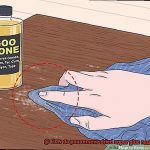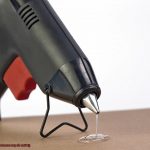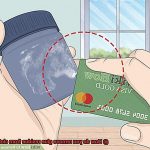Got a linoleum floor that’s been marred by the stubborn remnants of glue? Whether you’ve just finished a DIY project or bid farewell to an old carpet, dealing with that unsightly sticky mess can be a real headache. But fear not, because we’re here to spill the beans on how you can successfully banish glue residue from your linoleum floor.
Picture this: you step into your kitchen or living area and are greeted by a linoleum floor that’s fresh and gleaming, practically dancing in the sunlight. No more eyesores or annoyingly sticky patches to ruin your day. All it takes is a little know-how and some simple techniques, and you’ll have your linoleum looking as good as new.
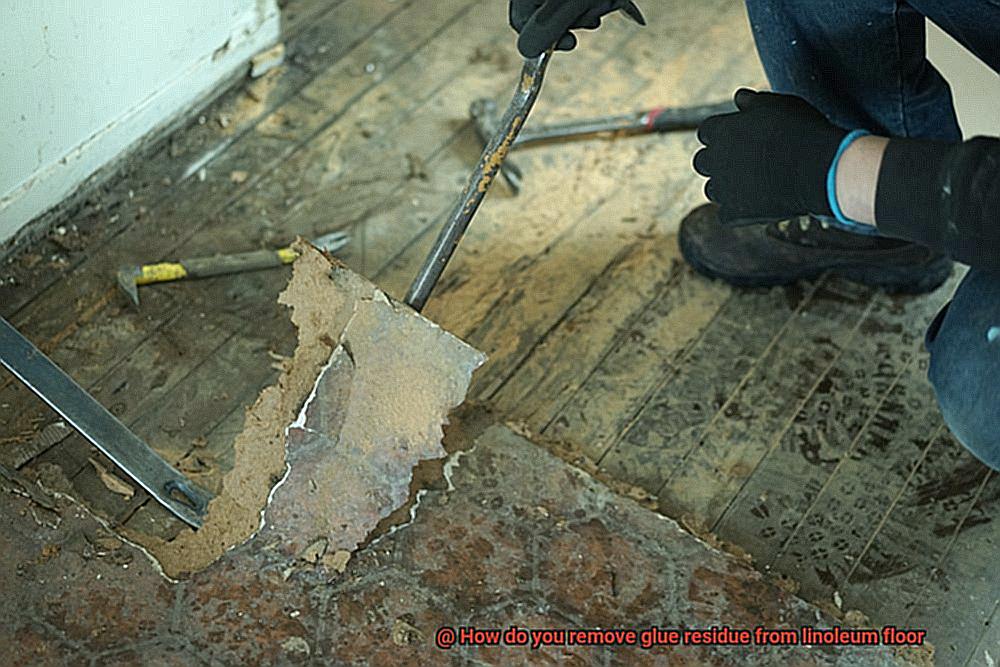
In this captivating blog post, we’re going to dive into expert tips and tricks that will effortlessly rid your linoleum floor of any trace of glue residue. We’ll explore effective solutions tailored specifically to your needs, all while embracing sustainable practices. From natural remedies to commercial products, we’ve got all the bases covered.
Our journey will take us through the delicate process of preparing your linoleum surface, choosing the perfect adhesive removers, and executing flawless removal techniques. Plus, we’ll address any concerns you might have about potential damage or discoloration of your beloved flooring.
So, if you’re up for an adventure that will transform your linoleum floor and bid farewell to pesky glue residue once and for all, hop on board. We’re about to arm you with all the knowledge you need to reclaim that sparkle in no time.
Types of Glue and How to Identify Them
Contents
- 1 Types of Glue and How to Identify Them
- 2 Preparing the Area for Removing Glue Residue
- 3 Commercial Adhesive Removers – What Are They and How to Use Them
- 4 Natural Solutions – White Vinegar and Rubbing Alcohol
- 5 Heat as a Removal Method – Pros and Cons
- 6 Additional Tips for Removing Glue Residue from a Linoleum Floor
- 7 Common Mistakes to Avoid When Removing Glue Residue
- 8 Conclusion
Removing glue residue from a linoleum floor can be a challenging task, but fear not. With the right knowledge, you can identify the type of glue used and choose the appropriate removal technique. Let’s dive into the fascinating world of glues and unravel the secrets to restoring your linoleum floor’s pristine condition.
Water-based Glue – The Friendly Stickiness:
Water-based glues are the go-to choice for DIY projects and crafts due to their ease of use and clean-up. If you find that water-based glue has left its mark on your linoleum floor, worry not. You can easily remove it by dampening a cloth or sponge with warm water and gently rubbing the affected area. For stubborn residue, a mild detergent or soap can be used. Remember to avoid harsh chemicals or abrasive materials that could harm the linoleum’s surface.
Solvent-based Glue – The Mighty Challenge:
Solvent-based glues, such as epoxy or construction adhesives, boast incredible bonding properties but pose a greater challenge when it comes to removal from linoleum floors. To conquer this mighty challenge, you’ll need specific solvents or adhesive removers. Acetone or nail polish remover containing acetone acts as a superhero in dissolving these types of glues. Apply a small amount to a clean cloth and gently rub the glue residue until it loosens and comes off. Be cautious not to leave acetone on the linoleum for too long, as it can cause damage.
Rubber-based Glue – Sticky Situation Solved:
Rubber-based glues like contact cement or rubber cement are commonly used for bonding rubber materials but can leave behind sticky residue on linoleum floors if not properly cleaned up. Fortunately, there is an easy solution. Reach for rubbing alcohol or isopropyl alcohol to save the day. Apply a small amount to a clean cloth and gently rub the affected area until the residue dissolves. Rinse the area with warm water and ensure it is thoroughly dried.
Hot Glue – Melting Away Stickiness:
Hot glue, also known as hot melt adhesive, is a popular choice for various crafts and projects due to its quick-drying nature. If hot glue residue has found its way onto your linoleum floor, fear not.
The secret lies in applying heat to soften the glue. Use a hairdryer on low heat or a heat gun at a safe distance to warm up the glue. Once the glue softens, gently scrape it off using a plastic scraper or credit card. Be mindful not to scratch or damage the linoleum while removing the glue.
Preparing the Area for Removing Glue Residue
Are you ready to conquer the challenge of removing stubborn glue residue from your linoleum floor? Before you jump into battle, take a moment to properly prepare the area. By following these steps, you’ll ensure a seamless removal process without any casualties to your precious floor or surrounding surfaces. So, don your superhero cape and let’s get started.
Step 1: Assemble Your Tools
First things first, gather all the necessary materials and tools. Arm yourself with a plastic scraper, a soft cloth or sponge, warm water, mild detergent, adhesive remover, and don’t forget those protective gloves. Think of it as assembling your superhero toolkit, ready to take on any sticky situation.
Step 2: Clear the Battlefield
Now that you have your toolkit ready, it’s time to clear the area of any furniture or objects that might hinder your mission. Create ample space to work your magic and prevent any accidental collateral damage. After all, it’s much easier to defeat the glue without any obstacles in your path.
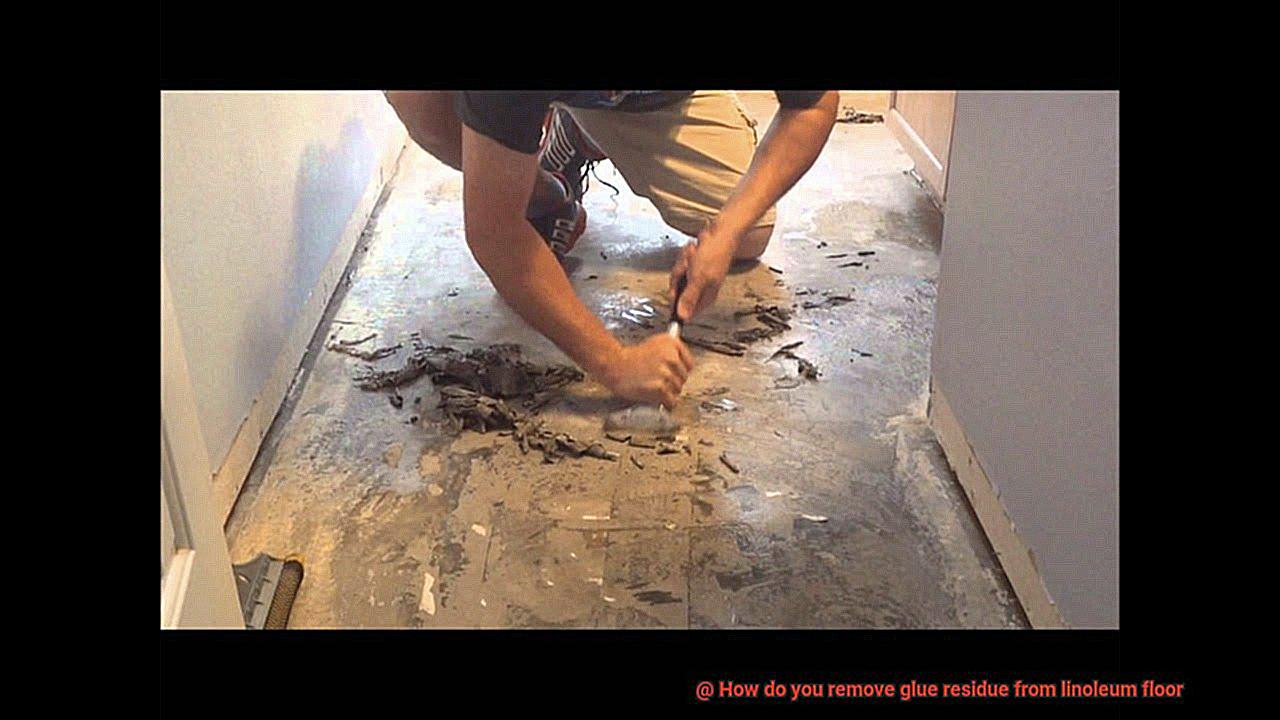
Step 3: Shield Your Surroundings
Just like a superhero protects innocent bystanders, safeguard your surrounding surfaces or furniture from potential harm. Lay down plastic sheets or drop cloths as a protective shield against any stray adhesive remover or the mighty powers of your scraper. Keep those surfaces safe from harm.
Step 4: Vanquish Loose Residue
If there are any loose pieces of glue residue lurking on your linoleum floor, now is the time to defeat them. But remember, finesse is key here. Wield your trusty plastic scraper with gentle precision to lift off those stubborn remnants without leaving a trace of scratches or harm.
Step 5: Unleash Your Cleaning Powers
With the loose residue conquered, it’s time to unleash your cleaning prowess. Dampen a soft cloth or sponge with warm water and mild detergent, and embark on a mission to banish any dirt or grime hiding on top of the glue residue. Rinse your cloth or sponge frequently, ensuring you’re not just spreading dirt around like a messy superhero.
Step 6: Patience, Young Warrior
After your victorious cleaning spree, exercise patience and give your linoleum floor time to dry completely. This period of rest will allow any adhesive remover or cleaning agents you use later to work their magic more effectively. Remember, a true hero knows the power of patience.
Commercial Adhesive Removers – What Are They and How to Use Them
Fear not, for I am here to equip you with the knowledge of commercial adhesive removers. Brace yourself as we delve into the realm of these magical elixirs, learning what they are and how to wield their power to vanquish even the most resilient glue remnants. Prepare to embark on a heroic journey through the world of commercial adhesive removers.
What Are Commercial Adhesive Removers?
Imagine a mighty arsenal of specially formulated products, designed to eradicate glue residue from any surface, including linoleum floors. These formidable warriors take on various forms – sprays, gels, liquids, or wipes – and can be easily obtained from hardware stores or online retailers.
Solvent-Based Removers:
Among these fearless warriors stands the solvent-based remover, armed with powerful solvents that shatter adhesive bonds, making glue residue surrender with ease. To wield this potent weapon effectively, follow these steps:
- Begin by testing a small, inconspicuous area to ensure compatibility with your linoleum floor.
- Directly apply the adhesive remover onto the glue residue and allow it to settle for a few minutes.
- With a scraper or soft cloth, gently lift and remove the softened glue from its stronghold.
- As these solvents possess great strength, heed the manufacturer’s instructions, ensuring proper ventilation and protective gear.
Citrus-Based Removers:
For those who seek a safer alternative without compromising effectiveness, turn to the citrus-based remover – a beacon of hope created from natural orange oil extracts. These environmentally friendly heroes delicately yet relentlessly combat glue residue. Here’s how you can employ their power:
- Begin by testing a small area to ensure harmony with your linoleum floor.
- Apply the citrus-based remover onto the glue residue, allowing it to permeate for a few minutes.
- With finesse, lift and remove the softened glue using a scraper or soft cloth.
- Revel in the pleasant aroma, knowing that you have also contributed to preserving our planet.
Natural Solutions – White Vinegar and Rubbing Alcohol
Fear not, for we have two natural warriors at our command – white vinegar and rubbing alcohol. These formidable solutions possess the secret to dissolving glue with ease. Prepare to be amazed as we delve into the enchanting world of white vinegar and rubbing alcohol, and say goodbye to pesky glue residue forever.
The Mighty White Vinegar:
Behold, the versatile hero of household cleaning – white vinegar. With its acidic properties, this mighty liquid holds the key to conquering glue residue on your linoleum floors. Brace yourself for the power of white vinegar:
- Create a powerful potion by diluting white vinegar with water in a 1:1 ratio.
- Equip yourself with a cloth or sponge soaked in the vinegar solution and gently apply it to the glue residue.
- Let the magic happen as the vinegar solution breaks down the adhesive, dissolving it from your floor.
- Unleash your scrub brush or sponge, attacking the glue in circular motions until it surrenders.
- Rinse away any lingering residue with warm water, repeating the process if necessary until your victory is complete.
The Solvent Superhero – Rubbing Alcohol:
Prepare to meet our next ally in this epic battle – rubbing alcohol, the solvent superhero. With its ability to dissolve various adhesives, including glue, rubbing alcohol is ready to save the day. Witness its extraordinary power:
- Immerse a cloth or sponge in rubbing alcohol, arming yourself against the glue residue.
- Apply the alcohol-soaked cloth directly to the affected area, allowing it to penetrate and weaken the adhesive.
- Exercise patience as the rubbing alcohol works its magic, softening the glue for an easy defeat.
- Seize a clean cloth or sponge and wipe away the weakened glue, leaving your floor victorious.
- Ensure all traces of alcohol are banished by rinsing the area with warm water, restoring your linoleum’s pristine appearance.
Caution and Considerations:
While white vinegar and rubbing alcohol are our mighty allies, caution is crucial to ensure success in our quest:
Heat as a Removal Method – Pros and Cons
Glue residue on your beautiful linoleum floors can be a real headache. But fear not, my friend. As the trusted expert in this field, I am here to shed some light on the sizzling debate of using heat as a removal method. In this scorching article, we will explore the pros and cons of harnessing the power of heat to conquer that stubborn glue residue. So grab a seat and get ready for an exhilarating journey.
Heat Method #1: Hairdryer or Heat Gun:
Pros:
Cost-effective: Put your wallet at ease, as this method won’t burn a hole in it.
Cons:
Heat Method #2: Hot Water or Steam:
Pros:
- Eco-friendly: Say goodbye to harsh chemical products – simply pour boiling water or use a steam cleaner for an environmentally friendly approach.
- Effective: The heat works its magic, loosening the adhesive and allowing for effortless wiping away.
Cons:
- Potential damage: Proceed with caution, as excessive moisture can cause harm to certain types of linoleum floors.
- Not suitable for all scenarios: While effective in most cases, stubborn glue residue or specific adhesives may require alternative methods.
Heat Method #3: Iron and Cloth:
Pros:
- Quick and efficient: This method is like a blazing bullet, allowing for precise control of heat application and making it a swift removal option.
- Excellent for precision work: Ideal for targeting smaller areas of glue residue with pinpoint accuracy.
Cons:
Handle with care: Caution is paramount to avoid scorching your linoleum floor with excessive heat or prolonged contact with the iron.
Additional Tips for Removing Glue Residue from a Linoleum Floor
Fear not. We have curated a list of expert tips that will help you bid farewell to that stubborn mess and restore your linoleum floor to its former glory. From harnessing the power of heat to unleashing the magic of natural remedies, these six tried-and-true methods will have your linoleum looking brand new in no time.
Unleash the Power of Heat:
Prepare to conquer glue residue with the mighty force of heat. Equip yourself with a hairdryer or heat gun, set on low. Gently apply heat to the glue residue, allowing it to soften. Beware of overheating, as it can wreak havoc on your linoleum. Once the glue becomes pliable, wield a plastic scraper or putty knife to delicately scrape away the remnants. Revel in the satisfaction of a sticky-free floor.
Embrace the Vinegar Solution:
Say hello to the natural wonder that is white vinegar. Mix equal parts white vinegar and warm water in a spray bottle. Directly spritz this concoction onto the glue residue and grant it a few minutes to work its magic. Armed with a cloth or sponge, wipe away the softened residue. Should stubborn spots persist, enlist the aid of a plastic scraper or putty knife to banish every last trace of glue.
Call upon Rubbing Alcohol:
Summon rubbing alcohol to your aid and watch as it dissolves glue residue before your very eyes. Moisten a cloth or sponge with this magical elixir and lovingly rub away at the stubborn remnants until they capitulate. Rinse the area with warm water, gently wiping it dry. Your linoleum floor will gleam with gratitude.
Harness the Power of Commercial Adhesive Removers:
When in need of a ready-made solution, turn to the prowess of commercial adhesive removers. These specialized products are designed to triumph over even the most obstinate glue residue on various surfaces, including linoleum floors. Adhere to the instructions diligently, applying the remover to the glue residue and allowing it to work its wonders for a few minutes. Then, with a cloth or sponge, obliterate the softened residue.
Scrub Away the Troubles:
When faced with tenacious glue residue, unleash the scrubbing pad or brush, along with a gentle cleaning solution. Create this powerful concoction by blending warm water with a mild dish soap or floor cleaner. Vigorously scrub the affected area in circular motions, loosening the grip of the glue residue. Rinse thoroughly with clean water and lovingly wipe dry. Prepare to be mesmerized by your linoleum floor’s newfound radiance.
Prevention is Your Ally:
Common Mistakes to Avoid When Removing Glue Residue
Fantastic. But hold your horses before you leap into action. It’s crucial to be aware of the frequent blunders that could turn your once beautiful linoleum into a disaster zone. In this article, we’ll guide you through the pitfalls to avoid and provide expert tips on how to safely and effectively remove glue residue from your linoleum floors.
Say No to Harsh Chemicals and Abrasive Tools:
One of the biggest mistakes people make is resorting to harsh chemicals or abrasive tools in a desperate attempt to speed up the removal process. Beware. These quick fixes can inflict irreversible damage on your linoleum floor. Steer clear of steel wool or potent solvents that can scratch or dull the surface.
Prep Work is Key:
Don’t underestimate the power of preparation when it comes to removing glue residue. Take the time to meticulously clean the area, eliminating any loose debris or dirt. This ensures that your removal efforts focus solely on the glue residue itself, maximizing your chances of success.
Gentle and Patient Wins the Race:
Remember, removing glue residue requires finesse. Applying excessive force or scraping too aggressively can leave your linoleum floor marred and damaged. Instead, exercise patience and allow the appropriate products and methods to work their magic. Give them ample time to work effectively without rushing through the process.
Test Before You Apply:
Before slathering adhesive remover or cleaning solution onto your linoleum floor, always conduct a small test in an inconspicuous area. This simple step can save you from potential disasters as some products may discolor or harm the floor. Better safe than sorry.
Safety First:
Never overlook safety precautions when handling adhesive removers or cleaning solutions. Shield yourself from harm by donning the appropriate protective gear, such as gloves and goggles. Additionally, ensure proper ventilation in the area to prevent inhaling toxic fumes.
Don’t Rush It:
Removing glue residue demands time and patience, so resist the urge to rush the process. Allow the adhesive remover to penetrate and loosen the residue before attempting to scrape it off. Remember, haste can lead to incomplete removal or even inflict damage upon your linoleum floor.
d2k84OITGgE” >
Conclusion
Removing glue residue from a linoleum floor can be a frustrating task, but with the right approach, it can be conquered.
To tackle this sticky situation, there are several effective methods you can try. One option is to use a solvent-based adhesive remover specifically designed for linoleum floors.
These powerful solutions work by breaking down the glue and making it easier to remove. Another method involves using heat to soften the glue, which can then be scraped away with a putty knife or plastic scraper.
Whichever method you choose, make sure to test it in an inconspicuous area first to ensure it doesn’t damage your linoleum floor.



